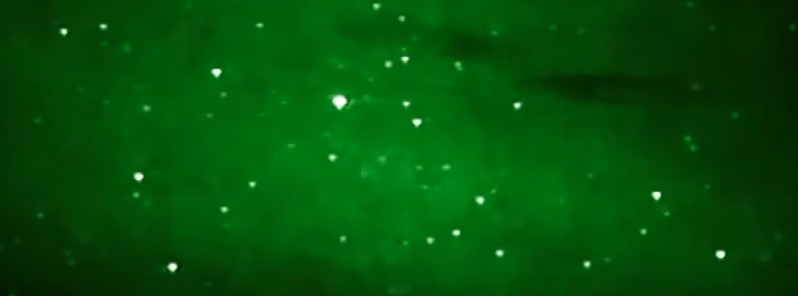Decades-old video footage reveals new type of aurora – Diffuse Auroral Eraser

Decades-old video footage has shown a never-before-seen aurora, which scientists at the University of Iowa called the Diffuse Auroral Eraser. This elusive type of aurora first appears as a brighter stripe within a fainter, more diffused aurora. When the stripe fades, it blots out the diffuse light from the background aurora, and after a few seconds, the diffuse background aurora reappears.
Scientists examined a video of the auroral phenomenon taken on March 15, 2002, by David Knudsen, a physicist from the University of Calgary. The video was shot in Churchill in Manitoba, Canada. Knudsen and his fellow researchers were not able to see the aurora with their own naked eyes, but the camera captured the phenomenon.
The physicist, who is also the new study's co-author, described, "What surprised me, and what made me write it in the notebook, is when a patch brightened and turned off, the background diffuse aurora was erased. There was a hole in the diffuse aurora. And then that hole would fill back in after a half-minute or so. I had never seen something like that before."
Allison Jaynes of the University of Iowa, one of the co-authors, learned about the video at a scientific meeting in 2010 and alerted fellow researchers to the phenomenon. "I knew there was something there. I knew it was different and unique. l had some ideas about how it could be analyzed, but I hadn’t done that yet. I handed it to Riley [Troyer], and he went much further with it by figuring out his own way to analyze the data and produce some significant conclusions."
Troyer, the lead author of the study, is no stranger to auroras. "I’ve seen hundreds of auroras growing up. They’re part of my heritage, something I can study while keeping ties to where I’m from," he said.
"The most valuable thing we found is showing the time that it takes for the aurora to go from an eraser event (when the diffuse aurora is blotted out) to be filled or colored again, and how long it takes to go from that erased state back to being diffuse aurora. Having a value on that will help with future modeling of magnetic fields."

The team then measured the average recovery time between the erasing to the reemergence of diffuse light as 20 seconds. The findings showed that "The biggest thing about these erasers that we didn’t know before but know now is that they exist," said Jaynes.
"It raises the question: Are these a common phenomenon that has been overlooked, or are they rare? Knowing they exist means there is a process that is creating them, and it may be a process that we haven’t started to look at yet because we never knew they were happening until now," she explained.
"Particles that fall into our atmosphere from space can affect our atmospheric layers and our climate. While particles with diffuse aurora may not be the main cause, they are smaller building blocks that can help us understand the aurora system as a whole, and may broaden our understanding of how auroras happen on other planets in our solar system."
Reference
"The Diffuse Auroral Eraser" – Troyer, R. N., et al. – JGR Space Physics – https://doi.org/10.1029/2020JA028805
Abstract
The source of diffuse aurora has been widely studied and linked to electron cyclotron harmonic and upper‐band chorus waves. It is known that these waves scatter 100s of eV to 10s of keV electrons from the plasma sheet, but the relative contribution of each wave type is still an open question. In this study, we report an interesting and unusual auroral feature observed on March 15, 2002. We believe that these observations could help further our understanding of waves associated with diffuse aurora. This diffuse auroral feature is characterized by four phases: (1) the initial phase exhibiting regular diffuse aurora; (2) the brightening phase, where an east‐west auroral stripe rapidly brightens; (3) the eraser phase, where the stripe dims to below its initial state; and (4) the recovery phase, where the diffuse aurora returns to its original brightness. Using a superposed epoch analysis of 22 events, we calculate the average recovery phase time to be 20 s, although this varies widely between events. We hypothesize that the process responsible for these auroral eraser events could be the result of chorus waves modulating diffuse aurora.
Featured image credit: University of Iowa

Commenting rules and guidelines
We value the thoughts and opinions of our readers and welcome healthy discussions on our website. In order to maintain a respectful and positive community, we ask that all commenters follow these rules:
We reserve the right to remove any comments that violate these rules. By commenting on our website, you agree to abide by these guidelines. Thank you for helping to create a positive and welcoming environment for all.